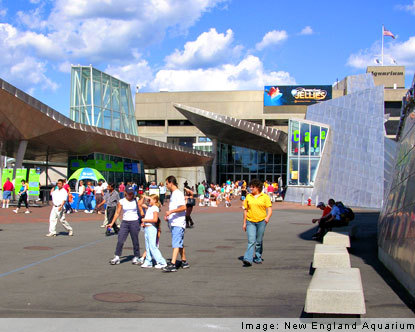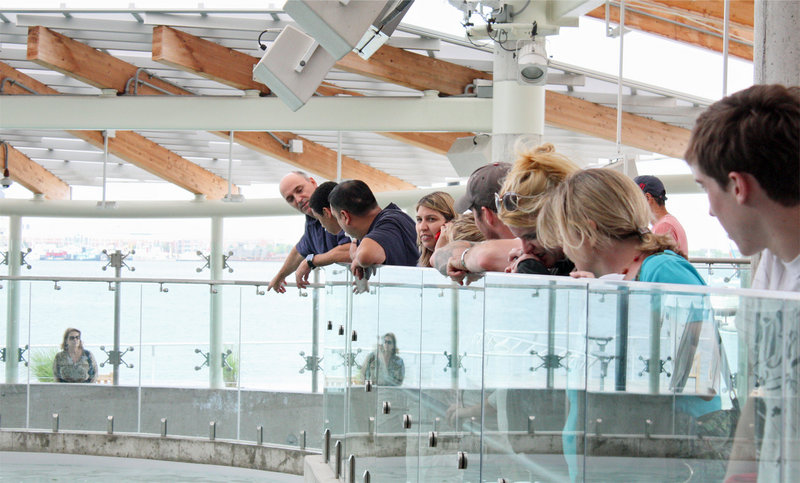BOSTON — I grew up just outside of Boston, and was lucky enough to have parents who took us without hesitation to all the key attractions in the city.
We went to the New England Aquarium soon after it opened in 1969, and returned regularly thereafter. I’ve been to Old Ironsides more times than I can possibly count.
As a family, we spent numerous Saturday nights at Haymarket Square absorbing the Italian culture of the North End. When Faneuil Hall was re-imagined as an urban marketplace in the 1970s, we were there.
I thought I knew Boston pretty well. But this summer, I realized I hardly know Boston at all. This summer, I rediscovered the Boston waterfront as a very different place than I knew in my youth.
I drove down for an opening at the Institute of Contemporary Art/Boston, which is a relatively new cultural institution in South Boston.
Great spot. I loved the exhibition and enjoyed the experience.
After the press hoo-ha at the ICA, a Boston-area friend and I were equally shocked to discover how easily the city opened up before us. We spent several hours on the Boston Harborwalk, a multi-use trail that conveniently connects South Boston to Charlestown. We explored about three miles on foot and with an MBTA ferry.
That’s just a tiny segment of the trail, which has been decades in the making. The Big Dig transformed Boston, but the Harborwalk makes it instantly and conveniently accessible.
All those stories about Boston traffic and how hard it is to get around town? Forget it.
Boston is a piece of cake.
Including the ICA, we visited five cultural institutions, and had lunch at a local food cart and a drink afterward. Not including admission to the museums or dinner, we spent less than $30. Most of that was for parking at the ICA.
And we did it all on foot, except for the ferry.
What I found most interesting was how different the city felt on the waterfront. I thought I knew this place. It used to be home, and I took pride in hopping on the Green Line and going anywhere the subway would take us.
But in terms of the waterfront, my knowledge seemed to end at the aquarium, the USS Constitution Museum or Haymarket. Everything else was out of reach, confusing.
Not anymore.
A combination of public investment and private enterprise has led to an economic revitalization of the waterfront, much of which is based around cultural attractions, said Julie Wormser, executive director of the Boston Harbor Association.
Among many other things, the association coordinates publicity and information about the waterfront, which has a series of summer activities planned to encourage people to get outside.
Dozens of institutions and entities contribute to its overall vitality, she said.
“It’s like a stone soup. Nobody adds much, but everyone adds a little. It becomes a feast,” Wormser said.
After the ICA, we walked to the Boston Children’s Museum, which is hosting a Native American arts exhibition through Labor Day. The exhibition features a number of Maine connections, including stories and profiles of Penobscot and Passamaquoddy Indians.
The museum is on Congress Street, along the Fort Point Channel and just a short walk from the ICA. Right outside its doors is the newly opened Boston Tea Party Museum. It reopened the week we were there, and includes interpretive exhibitions about the root causes of the Revolutionary War.
This museum was not around when I was growing up. Had it been, I would have done much better in history class.
From there, we hoofed it over to the New England Aquarium on Central Wharf. The aquarium has been an anchor tenant on the waterfront for more than 40 years, and one could argue that it led the redevelopment of the waterfront in terms of tourism. It is now one among many key institutions.
Tony LaCasse, an aquarium spokesman, told me that Harborwalk and the nearby Rose Kennedy Greenway have resulted in a spike in activity at the aquarium. Visitation is up, but just as significant, the number of people simply milling about on the plaza has mushroomed.
These folks are not necessarily paying to get into the aquarium, but are taking advantage of the free activities available in and around the plaza or eating in the public cafes. At night, especially when the Red Sox are on TV, The Reef outdoor restaurant is bustling with sports fans watching the game, he said.
“We’ve see a tangible difference in foot traffic in the last two years, in a big, big way,” LaCasse said. “It’s amazing what has happened here. You can now come to the city and do a lot of stuff for free or almost nothing. Whether it’s just walking around, or going to Quincy Market or into the North End, the city has just opened up.
“There is a new energy here that wasn’t here before. If you drive down from Maine, you can pay to park and do the waterfront for $20 or less, depending on what you want to do.”
From there, we hopped on an MBTA inner harbor ferry at Long Wharf ($3) and steamed over to the USS Constitution Museum at the Charlestown Navy Yard.
It was a short ride of maybe 15 minutes, but it offered perhaps the best view of the city I’ve seen from anywhere except on approach to Logan.
The USS Constitution Museum also has a new exhibition, this one dedicated to the War of 1812. The exhibition explains why the war began (lots of reasons) and its outcome (we won, sort of).
The War of 1812 is often treated as a footnote in history classes. Even now, the year of its bicentennial, it remains largely misunderstood, said Robert Kiihne, director of exhibitions for the museum.
“We looked at what people know, what they don’t know and why it’s significant,” he said.
Among the outcomes of the war, we got our flag, our National Anthem and the legitimacy of our Navy.
Visitors can tour the USS Constitution, or Old Ironsides, the Navy ship that earned its reputation in the War of 1812 and around which this museum is based. The ship was launched in 1797 and captured numerous British warships in the war.
The next time you go to Boston, think about parking your car, heading to the waterfront and exploring. I learned a lot about a city I thought I knew.
Staff Writer Bob Keyes can be contacted at 791-6457 or:
bkeyes@pressherald.com
Twitter: pphbkeyes
Send questions/comments to the editors.




